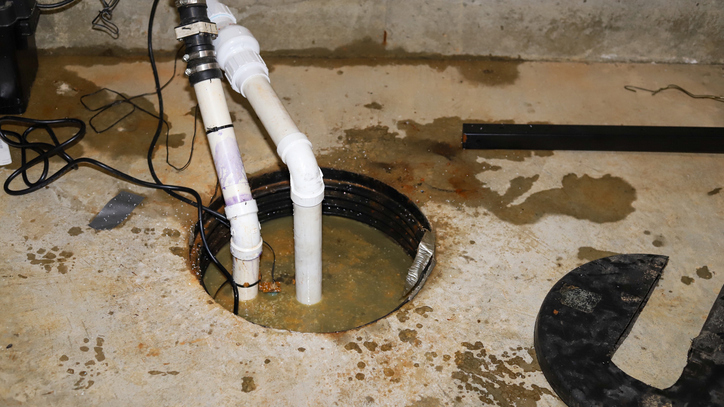From the outside, they look kind of the same. Both your sump pump and your ejector pump, are basically a hole in the floor, covered by a metal plate with pipes come up and out of that metal plate. So why do some homes need both kinds of pumps – and other homes don’t?
Every home with a basement needs a sump pump because no basement is truly waterproof. When it rains, the soil around your house becomes saturated with water. If the groundwater rises to or above the level of your basement floor, water will seep into your basement. Sump pumps sit in a pit or basin that collects water around your house through a drainage-tile system. When your sump pump is located correctly, at the lowest part of your basement, the excess water funnels toward the sump pit, filling it with water. The float switch rises with the water and when it hits a certain level, the switch turns on the pump, and the pump removes the water, moving it into a storm drain. This keeps your basement dry and snug.
When you live in neighborhoods prone to flooding, you may consider a larger pump and bigger basin. In addition to a standard electrical sump pump, home experts recommend installing a second battery-powered back up pump in the event of power outages during rain storms.
If you have a basement, you need a sump pump and basin.
Take a closer look at your ejector pump, if you have one. Unlike your sump pump’s removable lid, this metal lid is sealed shut. While a sump pump removes unwanted clear water from a leaky basement, an ejector pump removes sewage, waste and gray water. That’s why ejector pumps are sealed, to prevent sewage or sewer gas from entering your home.
Ejector pumps help move the waste up to the sewer line and out of the home when your basement level is lower than the sewer line. Ejector pumps are installed when:
- you have a bathroom or laundry room in the basement, located below your main plumbing and sewer lines
- your home builder assumed an owner would be adding a basement bathroom or laundry room in the future
- your home has previously had sewage back ups
Newer “grinder” ejection pumps are now available, especially for areas where sewer systems are overwhelmed. These grinder pumps collect wastewater from the whole home and process it before ejecting it to the main sewer line. This process places less pressure on the sewer system and can help prevent sewer back-ups.
The Maertin Heating & Cooling experts recommend you call an expert to install or replace either a sump pump or ejector pump. These are important mechanicals that not only keep your basement dry, they also protect the health of your family.
When you have questions about your HVAC system, call us at 708-479-9350. We are always happy to help!



